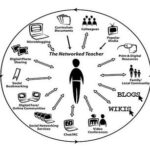This week’s topic allowed me to really reflect on inclusion and diversity in regards to my own Personal Learning Network, as well as its importance. I have had the pleasure of engaging with some of Shelly Moore’s material in the past, so I was extremely excited to hear what she had to say about this topic. As stated in the article One Without the Other : Stories of Unity Through Diversity and Inclusion, it is a teacher’s job to understand their students and cater to them (Moore, 2017). This makes it crucial for teachers to find creative ways to support all students, regardless of differences. As discussed in the video “Don’t Should on Me”, schools were originally standarished to mimic conditions of factories, yet not much change has been made to this system (0:45-1:34). Although there is no one way of being inclusive, teachers must recognize what the system was built for and adapt it to the current times (Moore, 2017). Inclusion has always been something extremely important to me, but also something that makes me extremely nervous. How can I adapt material to meet every single learner? Both Shelly Moore and Markiel Simpson helped me understand that social media can be an extremely helpful tool.
Shelley Moore discussed the idea of mentorship, and how this can be a powerful resource (3:50-5:13). Finding people you aspire to be like will allow you to find information and resources from a trusted source. Moore also discussed how social media provides a virtual community, and that followers are not just followers, but rather colleagues to learn from (8:25-9:42). She discussed how she once viewed social media as a place for marketing and communication, but now realizes how beneficial it can be for connecting and being interactive (13:51-14:20). One of the special aspects of social media is that it allows you to connect with people around the world, diversifying your community and getting all different kinds of perspectives and ideas. Markiel Simpson had similar ideas to Moore, and discussed his increase in followers over time. He emphasized the importance of having allies to amplify your message (18:50-19:30). He has had posts that have gone viral, which get spread to different platforms and help start a conversation. Once that community is built, people will reach out about specific posts they want to help with. Opportunities come out of having a strong online community.
Social media allows information to be spread efficiently and effectively. Advocacy can be seen in numerous ways including creating a post, sharing a post, liking a post, or sending the post to someone to start a conversation. Social media has evolved to allow for more choice, more opportunity for conversation and curation, more collaboration between media makers, and an increased number of creation by users (Clark & Aufderheide, 2011). Infographics and ideas can be created and spread extremely quickly, making advocacy very easy. By having a diverse learning network, individuals will be able to hear from multiple sources and gain the best understanding. Learning about a topic from someone who has experienced it first-hand allows for a unique perspective you may not have yourself. This allows you to think about topics in a different light, and see issues you may not have before. Prior to this week, I hadn’t thought much about the importance of having a diverse Personal Learning Network. However, I now see how important it is to understand unique topics from unique perspectives. Working together with an online community allows for valuable learning opportunities and experiences. I plan on researching educational activists both local and globally to follow on social media and begin branching out my Personal Learning Network even further.
Sources:
Clark, Jessica, and Patricia Aufderheide. “A New Vision for Public Media Open, Dynamic, and Participatory .” Media and Social Justice, 2011, pp. 55–67. UVIC Library, ezproxy.library.uvic.ca/login?url=http://www.palgraveconnect.com/doifinder/10.1057/9780230119796 .
Moore, Shelley. One Without the Other : Stories of Unity Through Diversity and Inclusion, Portage & Main Press, 2017. ProQuest Ebook Central, https://ebookcentral-proquest-com.ezproxy.library.uvic.ca/lib/uvic/detail.action?docID=4832579.
Moore, Shelley “Don’t Should on Me: It’s Not Easy Being NOT Green.” YouTube, 5 Nov. 2018, youtu.be/MeRNhz0nGts.
Moore, Shelley. “EDCI 338 – 20 Minutes Moore.” Youtube, uploaded by MILLER, 30 May 2021, https://www.youtube.com/watch?v=KeSV0rUl1bA&ab_channel=MILLER
Simpson, Markiel. “EDCI – 338 MARKIEL SIMPSON”. Youtube, uploaded by MILLER, 1 June 2021, https://www.youtube.com/watch?v=rsoDHGaXNNs&ab_channel=MILLER



hannahrochford
June 7, 2021 — 10:50 am
Hi Breanne! Great post. I think that having a diverse PLN will expand our knowledge and we can have a greater understanding of various issues and ideas. I love how you quoted Shelley when she said that there isn’t a certain way of being inclusive but teachers have to recognize how the system is built and learn to grow as times change. This makes me think that we should all just try our best to make sure every child feels safe in the classroom no matter who they are and just be willing to adapt.